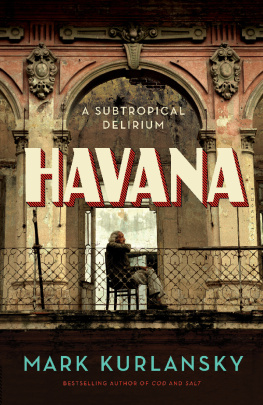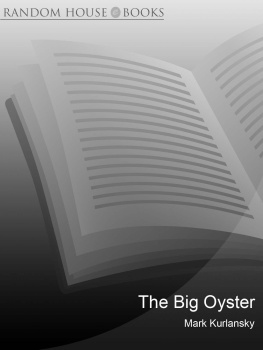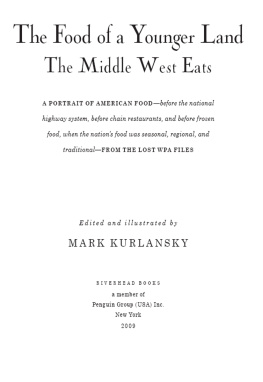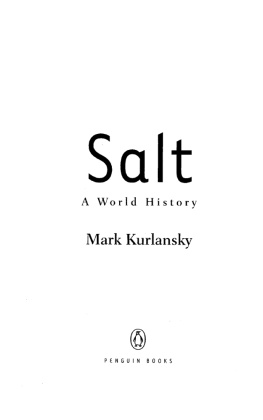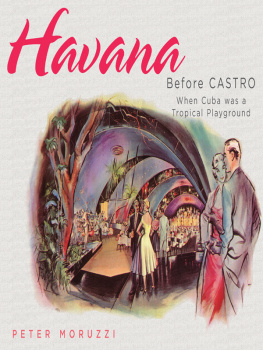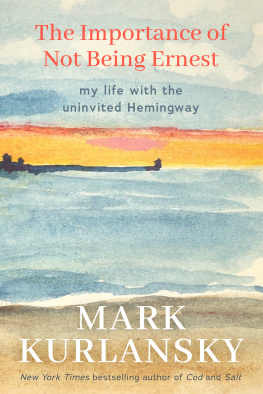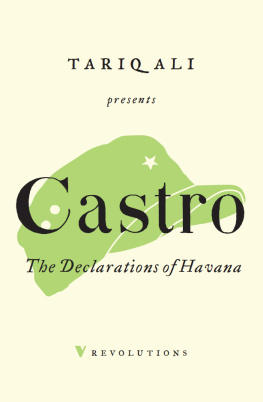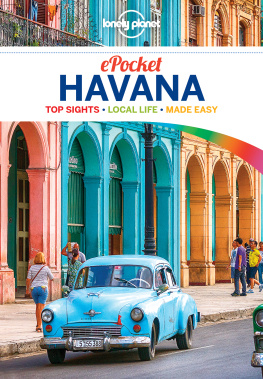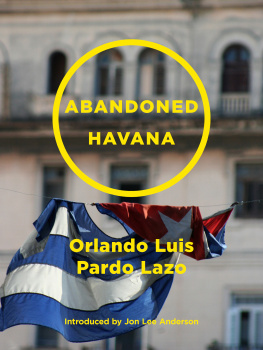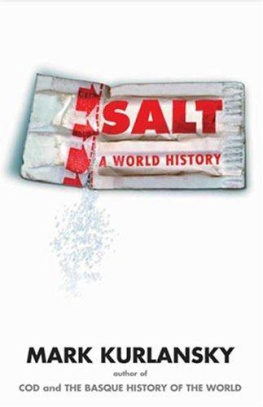Havana
BY THE SAME AUTHOR
nonfiction
Paper: Paging through History
International Night: A Father and Daughter Cook Their Way around the World
Ready for a Brand New Beat: How Dancing in the Street Became the Anthem for a Changing America
Birdseye: The Adventures of a Curious Man
Hank Greenberg: The Hero Who Didnt Want to Be One
What? Are These the 20 Most Important Questions in Human History Or Is This a Game of 20 Questions?
The Eastern Stars: How Baseball Changed the Dominican Town of San Pedro de Macoris
The Food of a Younger Land: A Portrait of American Food from the Lost WPA Files
The Last Fish Tale: The Fate of the Atlantic and Survival in Gloucester, Americas Oldest Fishing Port and Most Original Town
The Big Oyster: History on the Half Shell
Nonviolence: A History of a Dangerous Idea
1968: The Year that Rocked the World
Choice Cuts: A Savory Selection of Food Writing from Around the World and Throughout History
Salt: A World History
The Basque History of the World
Cod: A Biography of the Fish that Changed the World
A Chosen Few: The Resurrection of European Jewry
A Continent of Islands: Searching for the Caribbean Destiny
fiction
City Beasts: Fourteen Stories of Uninvited Wildlife
Edible Stories: A Novel in Sixteen Parts
The Belly of Paris by Emily Zola: A New Translation with an Introduction by Mark Kurlansky
Boogaloo on 2nd Avenue: A Novel of Pastry, Guilt, and Music
The White Man in the Tree and Other Stories
children/young adult
Frozen in Time: Clarence Birdseyes Outrageous Idea about Frozen Food
Battle Fatigue
World without Fish
The Story of Salt
The Girl Who Swam to Euskadi
The Cods Tale
Bloomsbury USA
An imprint of Bloomsbury Publishing Plc
1385 Broadway New York NY 10018 USA
50 Bedford Square London WC1B 3DP UK
www.bloomsbury.com
BLOOMSBURY and the Diana logo are trademarks of Bloomsbury Publishing Plc
First published 2017
Mark Kurlansky, 2017
Sketches page numbers
Mark Kurlansky
All rights reserved. No part of this publication may be reproduced or transmitted in any form or by any means, electronic or mechanical, including photocopying, recording, or any information storage or retrieval system, without prior permission in writing from the publishers.
No responsibility for loss caused to any individual or organization acting on or refraining from action as a result of the material in this publication can be accepted by Bloomsbury or the author.
Excerpt from Cuba Libre copyright 1948 by Langston Hughes and Ben Frederick Carruthers. Copyright renewed 1976 by George Houston Bass, executor of Langston Hughes. By permission of Harold Ober Associates Incorporated.
ISBN: HB: 978-1-63286-391-1
EPUB: 978-1-63286-393-5
Library of Congress cataloging-in-publication data is available.
To find out more about our authors and books visit www.bloomsbury.com. Here you will find extracts, author interviews, details of forthcoming events and the option to sign up for our newsletters.
Bloomsbury books may be purchased for business or promotional use. For information on bulk purchases please contact Macmillan Corporate and Premium Sales Department at specialmarkets@macmillan.com.
To Cuban writers, the ones who supported the Revolution, the ones who opposed it, and the ones who did both.
CONTENTS
Esta especie de ensoacon o desvario subtropical, bajo el sol, al borde de la baha hermosa, diablicamente hermosa, abierta a las peligrosas aguas del golfo de Mxico, atestadas de tiburones y de almas en pena.
This subtropical delirium, under the sun, by the edge of a beautiful bay, diabolically beautiful, open to the perilous waters of the Gulf of Mexico, swarming with sharks and lost souls.
ABILIO ESTVEZ , Los Palacios Distantes ( 2002 )
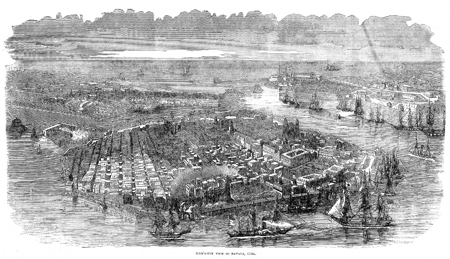
HABANA VIEJA SEEN FROM THE SEA, FROM ILLUSTRATED NEWS, JULY 23, 1853

El corazn es un loco
que no sabe de un color.
The heart is a fool
that knows no color.
JOS MART , Versos Sencillos ( 1891 )
If I were ever to make an old-fashioned film noirwith a cynical plot full of intrigue, violence, and sudden twists, filmed on dark and menacing streets in misty black and whiteI would shoot it in Havana.
My reason for choosing to shoot in black and white might not be immediately apparent to people who know Havana. Havana is a Caribbean city with yellow and pink and turquoise buildings set against a hot cerulean sky and a sea that is bright blue with a dark cobalt stripe formed by the Gulf Stream, always present in the distance.
Sometimes, as Americans in particular have occasionally observed, the sea off of Havana can appear violet when it reflects the sky moments before daybreak. Ernest Hemingway, for whom violet would have been too flowery a word, described the Gulf Stream there as nearly purple. But Habanerosthat is, the people of Havanatend to be less poetic about the sea, and the only one I ever found who thought the waters of Havana were violet was the mid-twentieth-century Habanero poet and novelist Jos Lezama Lima, who wrote:
The violet sea longs for the birth of gods,
For to be born here is an unspeakable feast...
John Muir, the Scot who became Americas great naturalist and perhaps first environmentalist, went to Cuba in 1868 , the same year he first saw and made famous Yosemite. To Muir, Havana was a yellow city: On one side of the harbor was a city of these yellow plants; on the other, a city of yellow stucco houses, narrowly and confusedly congregated. Muir found yellow everywhere. The hill on which the Morro Castle guards the opening of the harbor, according to Muir, was covered with yellow weeds.
Similarly, British novelist Anthony Trollope, on his 1859 visit, called Havana the dingy yellow town. And that is how American Impressionist Childe Hassam painted it. Although he was a great colorist in New York, New England, and France, when he went to Havana in 1895 , he painted yellow buildings faded to pastel by the white-hot sunlighta dingy yellow town. In his paintings of Havana, even the shadows were mutedinto a pastel blueand the only true saturated colors were the red and gold of the Spanish flags. Hassam loved flags.
Contemporary Cuban writer Pedro Juan Gutirrez, who consciously avoids lyrical flourishes, made an exception for Havana at sunset, which he called the beautiful golden city in the dusk, and it is true that when the suns rays burn into the city at an angle almost parallel to the ground, Havana is a golden city.
Federico Garca Lorca, the great Spanish poet, is beloved in Havana for his boyish charm and because he came to a tragic endhe was shot by Fascists at the outbreak of the Spanish Civil War. Tragic endings always play well in Havana. But in 1930 he wrote, Havana has the yellow of Cdiz, the pink of Seville turning carmine and the green of Granada, with the slight phosphorescence of fish.
Were these writers seeing the same city that I was seeing?
One reason for the difference between these writers impressions, at least in the early accounts, and mine was that these writers first saw Havana from the sea.
Havana is located on the north coast of Cuba, along a primary shipping lane that runs between North America and Europe, and through the Caribbean to Mexico and South America. It and San Juan, Puerto Rico, which is situated much farther from North America and Mexico, are the only major Caribbean ports on the Atlantic Ocean. Most Caribbean ports are on the Caribbean side of their respective islands, where ships have to struggle through treacherous inter-island passages to get to the Atlantic.
Next page
